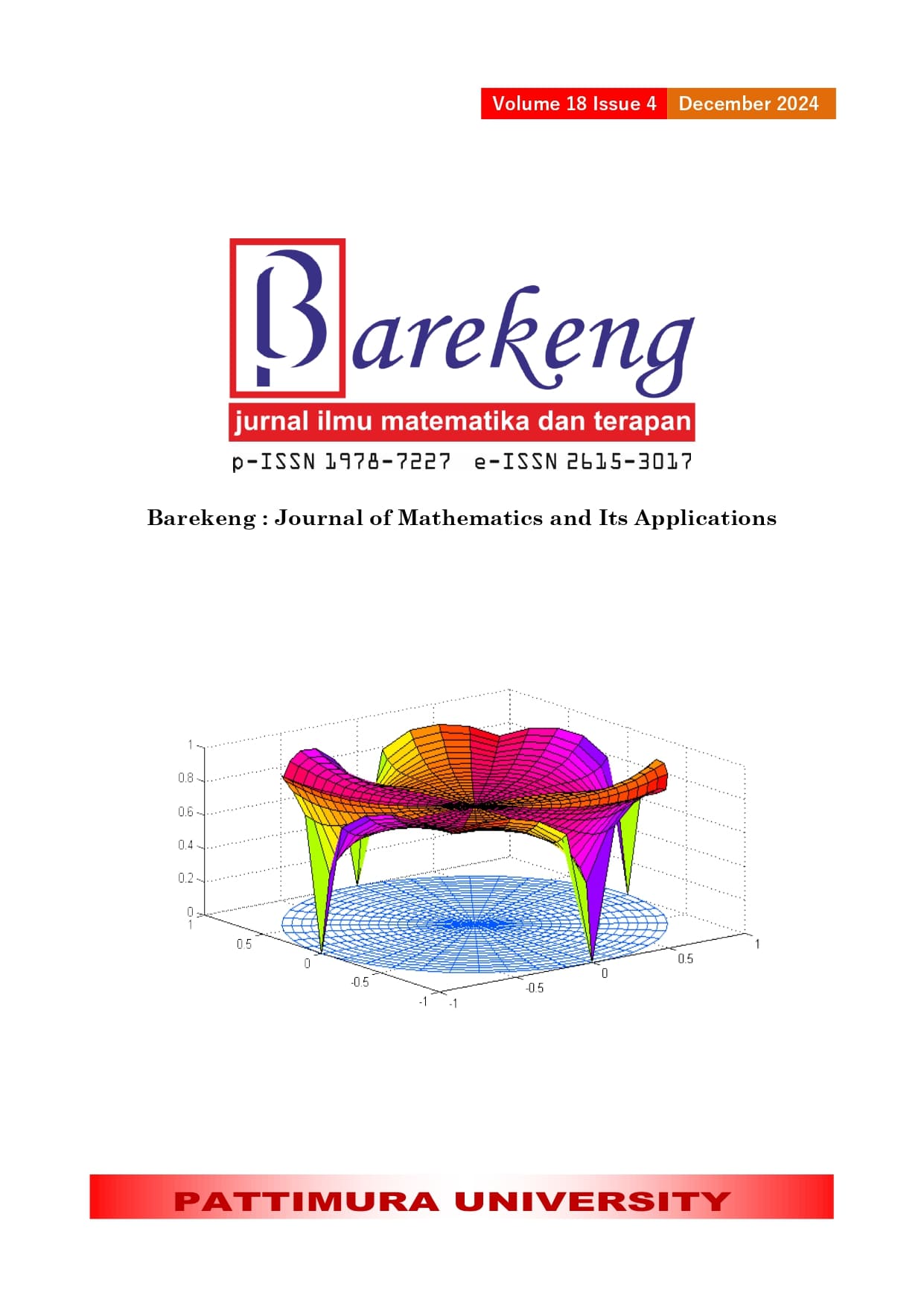APPLICATION OF K-MEANS++ WITH DUNN INDEX VALIDATION OF GROUPING WEST KALIMANTAN REGION BASED ON CRIME VULNERABILITY
Abstract
Crime is an unlawful behavior that will be given a punishment or sanctions based on Kitab Undang-Undang Hukum Pidana (KUHP) or other regulations in Indonesia. One of the provinces in Indonesia, namely West Kalimantan reported that criminal cases are increasing in 2021 and 2022. One of the solutions to minimize that case is grouping the district and city in West Kalimantan based on the level of vulnerability so the authority can be more responsive in solving these problems. The grouping can be done by cluster analysis. This analysis aims to group some objects based on the similarity of characteristics. K-Means++ is one of the methods of cluster analysis. K-Means++ is the development of K-Means, in which K-Means++ is smarter than K-Means in selecting the initial centroid because only one initial centroid is chosen randomly, and the initial centroids of the other clusters are done through calculations. This research uses secondary data from BPS of West Kalimantan, consisting of 10 variables. This research aims to form clusters to determine the level of vulnerability of each district and city in West Kalimantan. The selection of the optimal cluster is done by evaluating the cluster. One of these evaluations is the Dunn Index. Based on the analysis results, the optimum number of clusters is with a Dunn Index value of 0.55. The first cluster is categorized as non-vulnerable with ten members, the second cluster as vulnerable with three members, and the third cluster as very vulnerable with one member.
Downloads
References
R. E. Fajri and C. Z. Rizki, “Pengaruh Pertumbuhan Ekonomi, Kepadatan Penduduk, dan Pengangguran Terhadap Kriminalitas Perkotaan Aceh,” J. Ilm. Mhs., vol. 4, no. 3, pp. 255–263, 2019.
Pusiknas, “Statistik Kejahatan,” Pusat Informasi Kriminal Nasional. https://pusiknas.polri.go.id/data_kejahatan (accessed Sep. 18, 2023).
F. P. Marpaung, P. S. Ilham, Y. Chenata, and R. B. Nugroho, Provinsi Kalimantan Barat Dalam Angka 2023. Pontianak: BPS Provinsi Kalimantan Barat, 2023.
F. K. Gulagiz and S. Suhap, “Comparison of Hierarchical and Non-Hierarchical Clustering Algorithms,” Int. J. Comput. Eng. Inf. Technol., vol. 9, no. 1, pp. 6–14, 2017, [Online]. Available: www.ijceit.org
C. A. S. Fastaf and Y. Yamasari, “Analisa Pemetaan Kriminalitas Kabupaten Bangkalan Menggunakan Metode K-Means dan K-Means++,” J. Informatics Comput. Sci., vol. 3, no. 04, pp. 534–546, 2022.
H. Malikhatin, A. Rusgiyono, and D. A. I. Maruddani, “Penerapan K-Modes Clustering dengan Validasi Dunn Index Pada Pengelompokan Karakteristik Calon TKI Menggunakan R-GUI,” J. Gaussian, vol. 10, no. 3, pp. 359–366, 2021.
N. Nugroho and F. D. Adhinata, “Penggunaan Metode K-Means dan K-Means ++ Sebagai Clustering Data Covid-19 di Pulau Jawa,” TEKNIKA, vol. 11, no. 3, pp. 170–179, 2022.
N. Afira and A. W. Wijayanto, “Analisis Cluster Kemiskinan Provinsi di Indonesia Tahun 2019 dengan Metode Partitioning dan Hierarki,” Komputika J. Sist. Komput., vol. 10, no. 2, pp. 101–109, 2021.
S. Hanada and T. S. Yanti, “Penggunaan Analisis Cluster dalam Pengelompokan Kecamatan di Kabupaten Karawang Berdasarkan Metode Kontrasepsi Peserta KB Aktif,” Pros. Stat., pp. 42–49, 2021.
N. Ulinnuh and R. Veriani, “Analisis Cluster dalam Pengelompokan Provinsi di Indonesia Berdasarkan Variabel Penyakit Menular Menggunakan Metode Complete Linkage , Average Linkage dan Ward,” InfoTekJar J. Nas. Inform. dan Teknol. Jar., vol. 5, no. 1, pp. 101–108, 2020.
N. Thamrin and A. W. Wijayanto, “Comparison of Soft and Hard Clustering: A Case Study on Welfare Level in Cities on Java Island,” Indones. J. Stat. Its Appl., vol. 5, no. 1, pp. 141–160, 2021.
S. M. Miraftabzadeh, C. G. Colombo, M. Longo, and F. Foiadelli, “K-Means and Alternative Clustering Methods in Modern Power Systems,” IEEE Access, vol. 11, no. September, pp. 119596–119633, 2023, doi: 10.1109/ACCESS.2023.3327640.
A. S. Ahmar, D. Napitupulu, R. Rahim, R. Hidayat, Y. Sonatha, and M. Azmi, “Using K-Means Clustering to Cluster Provinces in Indonesia,” J. Phys. Conf. Ser., vol. 1028, no. 1, 2018, doi: 10.1088/1742-6596/1028/1/012006.
X. Linyao and W. Jianguo, “Improved K-means Algorithm Based on Optimizing Initial Cluster Centers and Its Application,” Atl. Press, vol. 79, pp. 5–10, 2018.
D. A. Pramudita and B. Sumargo, “Pengelompokan Pengguna Internet dengan Metode K-Means Clustering,” J. Stat. dan Apl., vol. 3, no. 1, pp. 1–12, 2019, doi: 10.21009/jsa.03101.
K. P. Sinaga and M. S. Yang, “Unsupervised K-means clustering algorithm,” IEEE Access, vol. 8, pp. 80716–80727, 2020, doi: 10.1109/ACCESS.2020.2988796.
M. S. Yang and I. Hussain, “Unsupervised Multi-View K-Means Clustering Algorithm,” IEEE Access, vol. 11, no. January, pp. 13574–13593, 2023, doi: 10.1109/ACCESS.2023.3243133.
H. Mahmood, T. Mehmood, and L. A. Al-Essa, “Optimizing Clustering Algorithms for Anti-Microbial Evaluation Data: A Majority Score-Based Evaluation of K-Means, Gaussian Mixture Model, and Multivariate T-Distribution Mixtures,” IEEE Access, vol. 11, no. May, pp. 79793–79800, 2023, doi: 10.1109/ACCESS.2023.3288344.
Copyright (c) 2024 Rifkah Alfiyyah Sary, Neva Satyahadewi, Wirda Andani

This work is licensed under a Creative Commons Attribution-ShareAlike 4.0 International License.
Authors who publish with this Journal agree to the following terms:
- Author retain copyright and grant the journal right of first publication with the work simultaneously licensed under a creative commons attribution license that allow others to share the work within an acknowledgement of the work’s authorship and initial publication of this journal.
- Authors are able to enter into separate, additional contractual arrangement for the non-exclusive distribution of the journal’s published version of the work (e.g. acknowledgement of its initial publication in this journal).
- Authors are permitted and encouraged to post their work online (e.g. in institutional repositories or on their websites) prior to and during the submission process, as it can lead to productive exchanges, as well as earlier and greater citation of published works.






1.gif)



